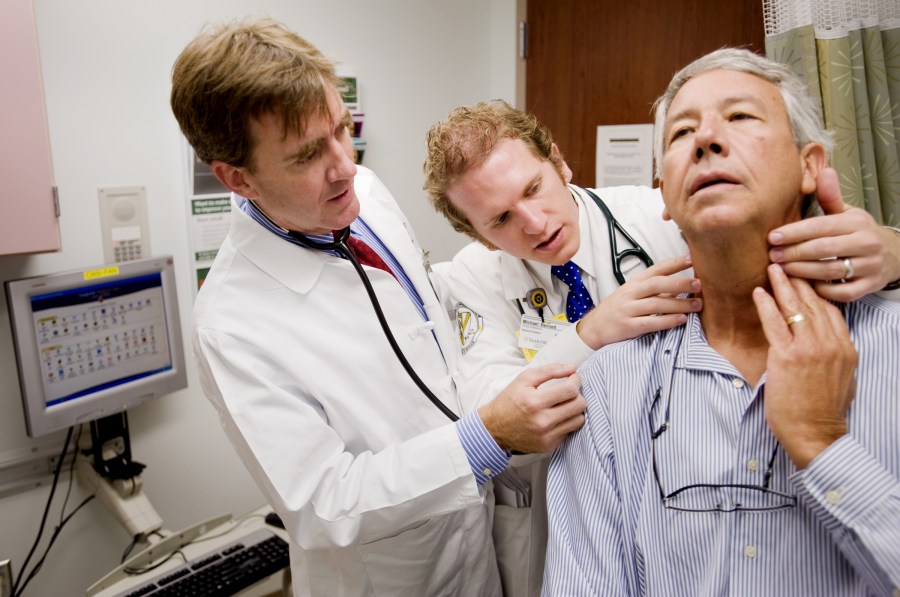
Anderson Spickard III, M.D., left, and third-year VUSM student Michael Bennett examine patient Jack Lance. (photo by Joe Howell)
Informatics drives innovative School of Medicine program
A pilot program at Vanderbilt University School of Medicine is using high-level informatics to enhance students' learning during third- and fourth-year rotations.
The program, called Vanderbilt Core Clinical Curriculum (VC3), uses technology to document each student's exposure to 25 carefully selected core medical problems to ensure they become well-prepared physicians.
“It was important that we devise learning objectives for a list of problems that each student should master by the end of medical school,” said program co-designer, Anderson Spickard III, M.D., M.S., associate professor of Medicine and Biomedical Informatics and director of medical clerkships for the Department of Medicine.
“It isn't everything they need to know, but if they know these, they will know a lot of medicine.”
Key elements of VC3 are:
• Students’ Star Panel patient notes from inpatient and outpatient rotations are copied to a program in Vanderbilt's Knowledge Map called “KM Portfolio.”
• Concepts in each note are automatically captured and matched to the 25 problems (examples include chest pain, trauma, altered mental status and abdominal pain).
• Master clinical teachers act as mentors to review the competency experiences with students throughout the year.
• Computerized reports help determine the extent of exposure to core clinical problems and a student's proficiency in each core problem.
“Using information from VC3 we can track students' exposure to areas of competencies and tailor experience and teaching to meet students' needs,” Spickard said.
By providing learning objectives that apply across all rotations, tracking experiences without intruding on the flow of clinical work and helping students to self-assess their progress along established competencies, Spickard says he hopes VC3 may one day re-define medical training, and perhaps medical practice as well.
“As practitioners, we learn and improve through our experiences every day. If we can prove that these core clinical competency descriptions and measurements are fair, reasonable and reliable, and we can match learning plans with resources for that person, then we envision a whole new paradigm of medical school that looks very different from what we have today,” Spickard said.
Students also see the program's benefits and potential.
“The fact that our notes are automatically pulled into the portfolio system and can then be categorized according to the 25 problems is quite amazing,” said Rebecca Cook, a third-year student who also served on the student VC3 Content Committee.
“I do think it has great potential to make learning easier and more efficient. VC3 provides another layer of structure and support that allows us to evaluate how we are developing and how much ground we are covering.”
“We are fortunate to have the informatics capabilities we have here to attack these challenges in a creative way, “ said Bonnie Miller, M.D., Senior Associate Dean for Health Sciences Education.
“Experiential learning has always been the dominant type of learning that takes place in the clinical clerkships, but patient mix has typically been haphazard, more by chance than by design. VC3 brings structure and consistency.”
The VC3 system is still growing; master clinical instructors at VUSM continue to refine the program, including determining how the basic science courses best prepare students to achieve clinical competencies. Student committees are also reviewing their experience with the pilot this year and will provide feedback.
Spickard said national organizations, including the National Board of Medical Examiners are in contact with his team to look at the concept of VC3 as one of the potential ways to determine competency of physicians in resident training and in clinical practice.













